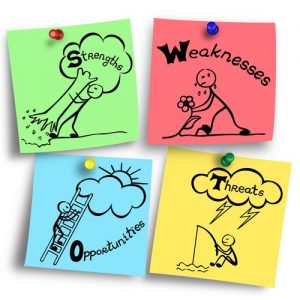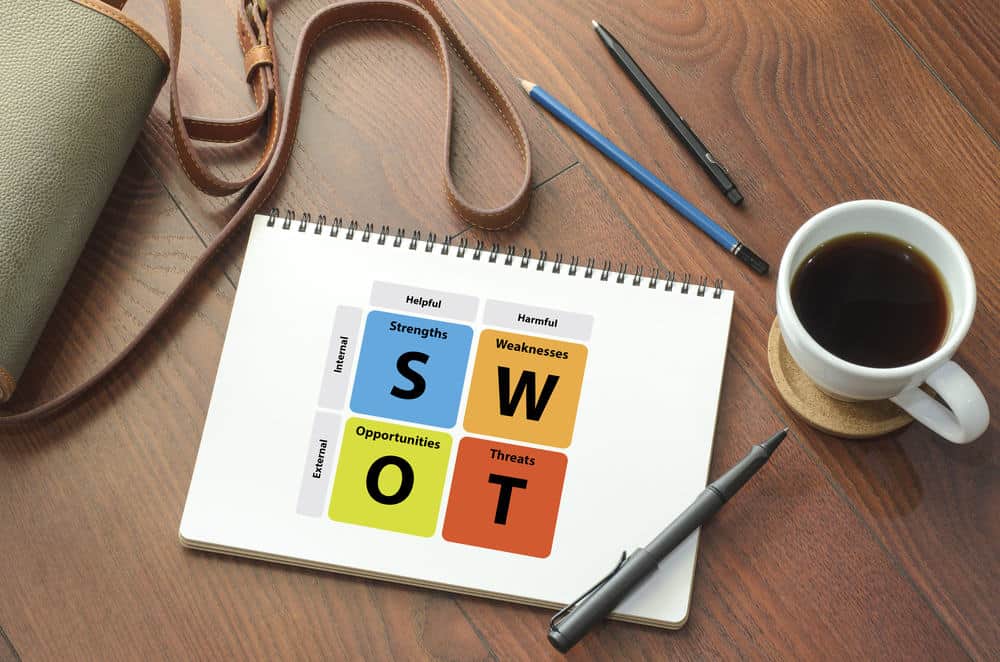Marketing experts are using one particular analysis to assess the most optimal strategy and tactics when promoting brands. It’s inevitable part and foundation of every marketing plan. But when applied to a person, rather than just to a business idea, SWOT analysis easily transforms into one of your most efficient weapons.
Why SWOT?
As we said, risks are not found in the idea, but in the person or the team who is about to bring that same idea into reality and execute a carefully developed plan. Even the best idea will eventually fail if the management team is incapable.
That’s one of the reasons why every business plan starts with the entrepreneur’s bio. It’s here where you can see if you are up to the task or is there something you need to fix/improve before you execute your plan.
[clickToTweet tweet=”Objective self-reflection will make the difference between success and fail – every time.” quote=”Objective self-reflection will make the difference between success and failure – every time.”]
And it’s not just the business we are talking about here. It can be anything. From achieving some goal (climbing Mt. Everest) to charity work (building schools and libraries in Africa).
Apply SWOT the moment you come up with the idea and you’ll have the clear vision of what you have to do (improve) to succeed.
What is SWOT in marketing
SWOT analysis.
Strength-Weaknesses-Opportunities-Threat.
Commonly, it means this:
Your strength is a quality product, but your weakness at the same time is the entirely new brand, unknown to the market. Yet, you have the opportunity here to challenge the already established brands since you’re offering something they don’t. Although, you must not underestimate their power and influence – they pose a threat to you. Thus, you need to list the ways they could potentially endanger your efforts.
It may sound confusing, but essentially it’s simple and logical. What you do, as a marketer, is comparing the idea you are about to promote against the top competitors – more the merrier.
How to apply SWOT on personal life
 In exactly the same way. Whenever you come up with an idea or have a challenge in front of you — no matter what that might be — you instantly start self-reflecting using the standard SWOT template.
In exactly the same way. Whenever you come up with an idea or have a challenge in front of you — no matter what that might be — you instantly start self-reflecting using the standard SWOT template.
Your job is to list and cross-analyze your:
- Strengths
- Weaknesses
- Opportunities
- Risks
However, unlike what marketers are doing, you will compare yourself against your idea and/or challenge.
For instance…
Let’s move one stair up on a corporate ladder and enter into management. Our current position is the production worker/office administration. We want to reach the first executive role (foreman, office manager…)
STRENGTHS
- 3 years of experience
- Understanding of the local processes and operations
- Positive attitude toward work and duties
- Ability to perform with the utmost efficiency in terms of speed and quality
- Determination and tendency to a healthy level of assertive behavior
WEAKNESSES
- Lack of experience in team leadership
- Limited knowledge about the overall organizational structure, responsibilities and operations
- Not being the only one with the optimal skill set
- The position is filled with the experienced person who knows his business
OPPORTUNITIES
- Higher paycheck
- Further progress
- Positive effect on ego and self-confidence
RISKS
- There is a real possibility to get fired if something goes wrong
- Sabotage attempts
Once we list everything, we work from the bottom up.
Risk of getting your ass fired is always here, no matter what your position is, so don’t sweat about it.
And the assholes and elbows are inevitable. There’s always someone who wants what you have and who will do everything in his/her power to fuck you up.
But that’s the advantage of starting from the lowest entry and then working your way up – you get to know the people that surround you. Even the superficial observation can yield potential assholes.
The opportunities are clear. They are the only reason why we are thinking about becoming executives. And, it’s not just about the money. It’s about personal ranking (establishment) within the collective. Being a hotshot executive boosts one’s ego and reflects positively in both professional and private life equally.
But as soon as we start thinking objectively, we see how there are gray areas. Things we have never met with. The duties we have never executed. Necessary organizational aspects that we have no clear understanding about since we’re never the part of the team who’s planning the operations.
And it’s here where our self-reflection must peak. We have to come very clean about what are we willing to do to improve:
If we are about to climb Mt. Everest, are we ready to engage in excruciating 6 months of preparations that, in all fairness, don’t guarantee success?
In our example, it means this: are we willing to expose ourselves in order to learn?
Because, the moment our colleagues notice that our behavior is changed, they will start deploying countermeasures to stop us. Ain’t nobody’s fool. Once you start asking questions and work more closely with your superior officer, everyone around you — including that superior officer — will know what you’ve been up to.
There’s a risk of getting fired!
The “promotion” example, we used can be used as the guidance in every challenge we are facing or in every goal we want to achieve.
But, with one crucial premise: SWOT analysis MUST BE OBJECTIVE.
In fact, the best approach is to use the “accountability person” or someone who will honestly examine your SWOT and point in inconsistencies or over exaggerated claims and conclusions.
Because, it’s hard to be honest to yourself about yourself. We are all freakin’ Superman’s when we daydream about our abilities. Reality is somewhat different.
The premise is simple
Whenever you are trying to achieve something, take five and self-reflect using the same SWOT analysis used in marketing. It’s arguably the best way to recognize the red, gray or completely dark areas we need to work on. As long as you keep it objective, it will be the most precise analytical tool in your arsenal and the only true guide to your success.








